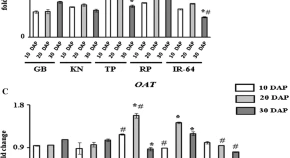Differential regulation of genes associated with aroma production in indica rice cultivars during grain developmental stages
Research Articles | Published: 26 March, 2020
First Page: 313
Last Page: 322
Views: 3647
Keywords: Rice, Gene expression, Days after pollination, Aroma, Principal component analysis, Semi quantitative reverse transcriptase-polymerase chain reaction
Abstract
The method of grain-filling during seed developmental process in rice is a complex process with the metabolite, hormone and aroma levels changing almost each day after pollination. The present study focused on transcript profiling of genes related to aroma production in the grains of four aromatic rice cultivars, viz., Gobindobhog, Kalonunia, Tulaipanji and Radhunipagal against the non-aromatic cultivar IR-64, collected at the intervals of 10 days after pollination (DAP), 20 DAP and 30 DAP. The BADH2 expression was significantly high in IR-64 grains, while the genes like P5CS and OAT were highly expressed in the aromatic cultivars. The P5C-producing genes (P5CS, PDH and OAT), along with TPI and DAO were found to be mostly increasing with seed maturity in Gobindobhog and Radhunipagal, all the aroma concerning genes, except P5CS exhibited lower expression in Tulaipanji at maturity. Although SPDS and SPMS expressions were recorded to be down regulated at maturity in all the aromatic varieties, the lowest expression was registered in Tulaipanji at 30 DAP developmental stage. The principal component analyses indicated towards close relations amongst the aroma related genes like TPI, PDH and OAT, and between P5CS and P5CDH. The aroma content was the highest at the 30 DAP stage in all the aromatic cultivars and was almost undetected in IR-64, which could be well correlated with the genes under study. Overall, this is the first novel report highlighting the differential expression pattern of aroma producing genes in connection to aroma formation in developing grains of the examined rice varieties.

References
- Alcazer R, Bitrian M, Bartels D, Koncz C, Altabella T, Tiburcio AF (2011) Polyamine metabolic canalization in response to drought stress in Arabidopsis and the resurrection plant Craterostigma plantagineum. Plant Signal Behav 6:243–250
- Banerjee A, Ghosh P, Roychoudhury A (2019) Salt acclimation differentially regulates the metabolites commonly involved in stress tolerance and aroma synthesis in indica rice cultivars. Plant Growth Regul 88:87–97
- Basu S, Roychoudhury A, Sengupta DN (2014) Identification of trans-acting factors regulating SamDC expression in Oryza sativa. Biochem Biophys Res Commun 445:398–403
- Bradbury LMT, Fitzgerald TL, Henry RJ, Jin Q, Waters DLE (2005) The gene for fragrance in rice. Plant Biotechnol J 3:363–370
- Costello PJ, Lee TH, Henschke PA (2001) Ability of lactic acid bacteria to produce N-heterocycles causing mousy-off flavor in wine. Aust J Grape Wine Res 7:160–167
- Ghosh P, Roychoudhury A (2018) Differential levels of metabolites and enzymes related to aroma formation in aromatic indica rice varieties: comparison with non-aromatic varieties. 3 Biotech 8:25
- Gill SS, Tuteja N (2010) Polyamines and abiotic stress tolerance in plants. Plant Signal Behav 5:26–33
- Hinge VR, Patil HB, Nadaf AB (2016) Aroma volatile analyses and 2AP characterization at various developmental stages in Basmati and non-Basmati scented rice (Oryza sativa L.) cultivars. Rice 9:38
- Huang TC, Teng CS, Chang JL, Chuang HS, Ho CT, Wu ML (2008) Biosynthetic mechanism of 2-acetyl-1-pyrroline and its relationship with ∆1-pyrroline-5-carboxylic acid and methylglyoxal in aromatic rice (Oryza sativa L.) callus. J Agric Food Chem 56:7399–7404
- Huang ZL, Tang XR, Wang YL, Chen MJ, Zhao ZK, Duan MY, Pan SG (2012) Effects of increasing aroma cultivation on aroma and grain yield of aromatic rice and their mechanism. Sci Agric Sin 45:1054–1065 ()
- Jakoby WB, Fredericks J (1959) Pyrrolidine and putrescine metabolism: γ-aminobutyraldehyde dehydrogenase. J Biol Chem 234:2145–2150 ()
- Li M, Ashraf U, Tian H, Mo Z, Pan S, Anjum SA, Duan M, Tang X (2016) Manganese-induced regulations in growth, yield formation, quality characters, rice aroma and enzyme involved in 2-acetyl-1-pyrroline biosynthesis in fragrant rice. Plant Physiol Biochem 103:167–175
- Mo Z, Ashraf U, Tang Y, Li W, Pan S, Duan M, Tian H, Tang X (2018) Nitrogen application at the booting stage effects 2-acetyl-1-pyrroline, proline and total nitrogen contents in aromatic rice. Chil J Agr Res 78:165–172
- Nadaf AB, Wakte KV, Zanan RL (2014) 2-Acetyl-1-pyrroline biosynthesis: from fragrance to a rare metabolic disease. J Plant Sci Res 1:102–108
- Paul S, Roychoudhury A (2019) Comparative analysis of the expression of candidate genes governing salt tolerance and yield attributes in two contrasting rice genotypes, encountering salt stress during grain development. J Plant Growth Regul 38:539–556
- Rizzi YS, Monteoliva ML, Fabro G, Grosso CL, Larovere LE, Alvarez ME (2015) P5CDH affects the pathways contributing to Pro synthesis after ProDH activation by biotic and abiotic stress conditions. Front Plant Sci 6:572
- Roychoudhury A, Basu S, Sarkar SN, Sengupta DN (2008) Comparative physiological and molecular responses of a common indica rice cultivar to high salinity with non-aromatic indica rice cultivars. Plant Cell Rep 27:1395–1410
- Sood BC, Siddiq EA (1978) A rapid technique for scent determination in rice. Indian J Genet Plant Breed 38:268–271
- Wijerathna YMAM, Kottearachchi NS, Gimhani DR, Sirisena DN (2014) Exploration of relationship between fragrant gene and growth performances of fragrant rice (Oryza sativa L.) seedlings under salinity stress. J Exp Biol Agric Sci 2:7–12
Author Information
Department of Biotechnology, St. Xavier’s College (Autonomous), Kolkata, India